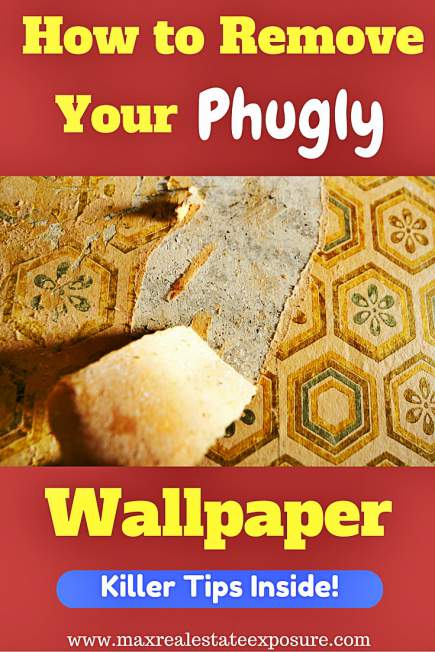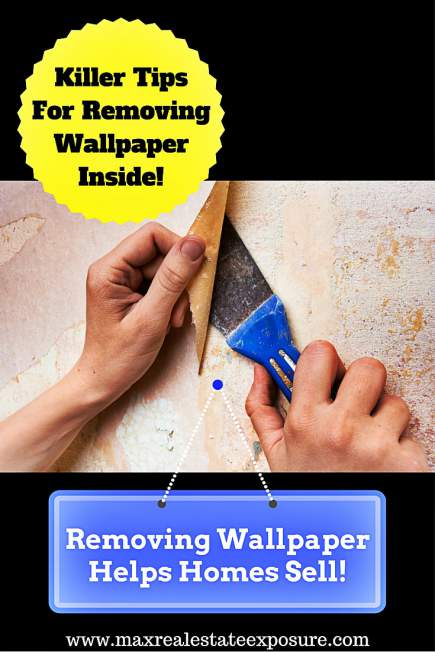 Are you wondering if you should remove the wallpaper in your home? Let’s cut to the chase – you should!
Are you wondering if you should remove the wallpaper in your home? Let’s cut to the chase – you should!
Specific tasks are always worth doing when you are selling a home. Mowing the lawn, for instance, makes sense. It is too easy and makes the house look so much better that it is foolish not to do it if you want to attract buyers.
Knowing how to remove wallpaper is another such task. Most buyers today do not appreciate wallpaper—it is old-fashioned and tends to date the home.
Wallpaper is an obvious thing to get rid of if you have the opportunity. Fortunately, removing wallpaper does not have to be complicated. With time and the proper technique, you can remove the wallpaper from the walls and move on with your sale.
Sellers always ask me if they should remove the wallpaper when selling their home.
My answer 99% of the time is yes! In fact, on many occasions, when they don’t ask, I need to tell them to remove it. Removing wallpaper is one of the best home improvements you can make.
Unfortunately, wallpaper dates a property in most circumstances. It is highly personalized, making it difficult for many buyers to picture a home as they want to see it.
So when sellers say, “I will give the buyer a repair credit, and they can just take the wallpaper down,” they are missing the whole point.
Wallpaper makes your home harder to sell. You will get far less money for your home when leaving the wallpaper.
From nearly forty years of experience being a Realtor there are few things that date a home worse than wallpaper. If you spend money on wallpaper before selling property, it is worse than throwing money out the window. It may cost you more in profits than what you spent on it.
Keep reading if you are ambitious and want to learn some excellent tips for removing wallpaper.
If not, having a painter or handyman remove it when you sell your home would still be advisable!
Do You Need To Remove The Wallpaper?
Only if you want to get the best price for the home!
While there is a possibility that you can find a buyer who just so happens to love the look of the wallpaper, the odds of that happening are slim. You and your real estate agent are trying to pull in as many qualified buyers as possible, but only a few of those buyers will make an offer.
Wallpaper is not a popular design choice right now with most people, so leaving it up risks driving off someone who will pay you enough money for your home. It is all about making your home more appealing to buyers. It becomes part of the home sale preparation to appeal to the masses.
When staging a house, eliminating it will be at the top of the list to start the process.
“Wallpaper is generally seen as an outdated thing of the past. Home sellers wanting to sell a home today want to convey to buyers that their home is up to date and move-in ready. Buyers seeing dated wallpaper are more likely to think what is hiding behind that or what other work I have to do before moving into this home in addition to taking down the wallpaper.Clean walls also mean the buyer is not distracted and can see the home for what it truly is. A living space they can move into and enjoy. As part of the home prep work done to get ready to sell, removing wallpaper should be on that list.
Compelling Reasons to Get Rid of It Before Selling
Removing wallpaper before selling a house is recommended for several reasons. The most vital is to enhance the property’s appeal and potential market value.
While this is always a challenging discussion with potential first-time home sellers, it’s worth it.
You don’t want to stop a seller from using your services; however, this discussion will help them in the long run. This message must be reinforced.
- Updates the Home’s Appearance: Wallpaper can make a home look outdated. Most buyers prefer paint because it is easier to change. It also offers a “clean slate” view of the home. Home staging experts always suggest neutral paint colors for a reason.
- Broadens Buyer Appeal: Wallpaper is a highly personal choice, and what you like may not appeal to potential buyers. For this reason, I always recommend my clients go with neutral paint colors, which
- Potential for Hidden Issues: Removing wallpaper can reveal hidden damages, such as dings and cracks, allowing you to repair them before selling. This ensures potential maintenance issues do not deter buyers.
- Reduces Buyer Concerns: Homes with wallpaper might give the impression of being out-of-date. This can raise concerns about deferred maintenance in buyers’ minds, especially with other issues to tackle.
- Maximizes Sale Price: Part of understanding how to sell a house is knowing how to get top dollar. Customizing wallpaper can make it challenging for buyers to envision the home as their own. Believe it or not, some buyers cannot see past things like this. Removing it and painting the walls in neutral colors can make the property more appealing and lead to better offers.
- Avoids the Paint-Over Option: Painting over wallpaper is not ideal as it can lead to bubbling or curling edges. It potentially causes more issues for the buyer and possibly affects the sale. You’re trying to go cheap instead of doing the job correctly.
Experience Dictates This Home Selling Advice
From many years of experience with wallpaper removal in homes, I have realized that it makes a house feel cleaner, updated, and more accessible for buyers.
The consensus among real estate professionals is clear: removing wallpaper is a worthwhile endeavor that leads to a quicker sale and potentially higher selling price.
If you are still deciding, ask your Realtor. What do they think about getting rid of the wallpaper? Chances are your Realtor will be all for eliminating the wallpaper, painting with beautiful neutral colors, and moving the home as quickly—and for as much money—as possible.
Getting Started Removing Wallpaper

Before you begin the removal process, you must take care of a few things. This includes:
Identifying What Type Of Wall You Have
You want to know what kind of walls your home has to safely remove the wallpaper. Homes over 50 years old are usually built with plaster walls—walls made of wood lathes covered in coats of plaster.
A plaster wall will sound dull when you knock on it and is much harder (difficult to put push pins in, for instance) than drywall.
If your home is less than 50 years old, the chances increase that it could be built with drywall.
Drywall is a lightweight material consisting of a chalky center and a thin cardboard cover on both sides. It sounds hollow and is much easier to penetrate with pins or nails.
Plaster walls are durable, while the cardboard on drywall can be easily damaged. Be gentle if you remove wallpaper from drywall.
Identify Your Wallpaper
There are several different kinds of wallpaper, each requiring a different removal method. Standard wallpaper can be sprayed with hot water and stripping solutions, while other types may require different tactics.
Keep reading to see some of the best tips for removing wallpaper by identifying the type you have.
Strip-able Wallpaper
There is strip-able wallpaper (consider yourself lucky if you have this), which can be pulled off the wall by hand. It requires no water or chemicals to remove. You can check if you have strip-able wallpaper by pulling at a corner of it.
If it comes away easily and doesn’t leave anything behind, great! Only newer wallpaper will be strip-able by hand, so don’t get your hopes up if you have older wallpaper.
Peel-able Wallpaper
With peelable wallpaper, you can peel off the vinyl top coat by hand and then use the regular water removal method to remove the paper that is left behind.
Washable Wallpaper
Washable wallpaper was designed to clean up quickly when it gets dirty. It has a plastic film on the surface to repel dirt and grime. The problem with washable wallpaper is that the plastic film prevents water from penetrating the paper for removal.
If you have washable wallpaper, you will need to puncture the plastic film before applying water.
Be careful not to cut too deeply, especially if you have drywall.
Prep For Removal
 Remove everything from the walls you are working on and remove all the furniture you can. If you can’t move some furniture, cover it to protect it.
Remove everything from the walls you are working on and remove all the furniture you can. If you can’t move some furniture, cover it to protect it.
Tape drop cloths to the baseboards to catch any materials that come off. You can place towels underneath the drop cloth to create a trough.
Gather all your tools together, including hot water, whatever applicator you will use, and your scraping tool.
Methods of Removing The Wallpaper
There are several different ways to remove wallpaper, depending on the type of paper and the difficulties you encounter.
Removing Wallpaper With Water
You have a few options for removing wallpaper with water. You can buy a liquid stripper concentrate from the hardware store, which helps peel the paper off, or try hot water alone – which can often work.
Some people also like to apply fabric softener as an alternative to the stripper concentrate.
Hot water will help soften the glue holding the paper. If the wallpaper is giving you trouble, you can rent a machine for steam removal, but many people successfully use a pump sprayer filled with boiling water.
If you don’t have a sprayer and don’t want to rent a steamer, apply the hot water with a broad brush.
Once you have used the water and the other products, you must let everything soak for a few minutes. Once the paper is thoroughly soaked, you can begin scraping off the wallpaper. Newer wallpaper will come away relatively quickly, while older wallpaper may take some real elbow grease to fully remove.
If you are having trouble getting the paper saturated, you can score the wallpaper before spraying to allow the water to penetrate better. Avoid doing this from the beginning, though, because you will often not need to score to get the paper off. Scoring is a lot of extra work, so avoid doing it unless necessary.
This Old House provides excellent tips for removing old wallpaper.
Do You Need A Steamer?
If you are having severe trouble getting the paper to come off, there is no shame in renting a steamer. It will probably make the job go a lot more quickly. Remember, if you are going the steamer route, make sure you have a friend to strip while you steam. It is a two-person job.
Are you the type that likes to watch a video? Check out this excellent visual guide on removing wallpaper via John Ripper on YouTube.
Prepping The Walls For Paint
Once you have removed all the wallpaper in your home, get your walls prepped for paint. This will make the result look more pleasing to your future buyer. According to My Paint Guide, here are the steps you should follow:
- Wash the Walls: Clean the walls with a sponge, warm water, and a cleaning solution like sugar soap. This step is crucial to removing any residue or bits left from the old wallpaper. Begin at the bottom and work your way up. Change the water as it gets dirty.
- Let the Walls Dry: Give the walls sufficient time to dry after washing. You can expedite the drying process by opening doors and windows. Using a fan can also be helpful.
- Sand the Walls: Once the walls are dry, use medium-grade sandpaper to smooth out rough patches or residues. After sanding, dust off the walls to remove any debris.
- Apply Filler: Prepare and apply filler to any cracks or gouges using a filling knife. Ensuring the filler is smooth and flush with the wall surface is crucial. If the damage is extensive, you might need to apply filler in layers. This will allow it to dry completely before adding more.
- Prime the Walls: Primer is essential to a smooth finish and to ensure the paint adheres properly. It also helps to cover any minor imperfections or filler that was applied. Do it Yourself recommends Zinsser Gardz as an excellent primer, especially on walls that have been through the wallpaper removal process. It seals old wallpaper adhesive chalky surfaces and creates a durable, moisture-proof layer.
- Skim Coat (If Necessary): A skim coat might be required if your walls are significantly damaged. This involves applying a thin layer of joint compound across the entire wall for an even, smooth surface. In a few homes, my clients have removed wallpaper that needed minor wall repairs. Most professional painters can handle this easily. Whether you need to skim coat depends on the extent of the damage.
By following these steps, you can ensure your walls are perfectly prepared for painting. It should result in a professional-quality finish. Remember, taking the time to prep your walls properly can dramatically affect the outcome of your painting project.
Final Thoughts
Leaving wallpaper behind when selling a home is often a huge mistake. While there are things you don’t need to fix, this isn’t one of them. Local real estate agents in your market can help you better understand how much money you may be leaving on the table by not removing the wallpaper. Very few homes I have seen did not benefit from stripping and removing the wallpaper.
Remember that picking the right wall color is critical once the wallpaper is removed. The best advice is to stay with a neutral tone. Although an off-white may seem boring, it is usually best.
Remember, you are not doing this to accommodate what you like but what the masses want. Selling a home for the most money means making it appeal to the most significant percentage of buyers.
Hopefully, this guide on removing wallpaper from your home has been helpful!
Other Useful Home Selling Articles
- Selling in a competitive real estate market: Kyle Hiscock shares via Rochester Real Estate Blog what you should know about home sales in hot real estate markets.
- Make your house more tempting to a buyer: Selling Warner Robbins shares its expertise on making a property the one buyers love.
- How to sell a house nobody wants: The Las Vegas Luxury Home Pro gives sound advice on selling a house nobody cares about.
Use these additional resources to make intelligent decisions when selling your home. When following the advice of pros, homes almost always sell quickly and for more money!
About the Author: Bill Gassett, a nationally recognized leader in his field, provided information on removing wallpaper. He is an expert in mortgages, financing, moving, home improvement, and general real estate.
Learn more about Bill Gassett and the publications in which he has been featured. Bill can be reached via email at billgassett@remaxexec.com or by phone at 508-625-0191. Bill has helped people move in and out of Metrowest towns for the last 38+ years.
Are you thinking of selling your home? I am passionate about real estate and love sharing my marketing expertise!
I service Real Estate Sales in the following Metrowest MA towns: Ashland, Bellingham, Douglas, Framingham, Franklin, Grafton, Holliston, Hopkinton, Hopedale, Medway, Mendon, Milford, Millbury, Millville, Natick, Northborough, Northbridge, Shrewsbury, Southborough, Sutton, Wayland, Westborough, Whitinsville, Worcester, Upton, and Uxbridge MA.

